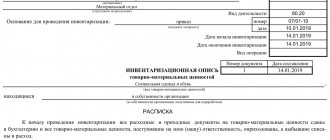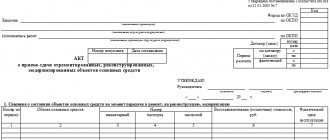Form INV-1 covers information on fixed assets both owned by the enterprise and those presented for temporary storage or leased. It is filled out when there is a need to balance a planned (for example, annual) or unscheduled (before the sale of a representative office) balance.
- Form and sample
- Free download
- Online viewing
- Expert tested
FILES
Under the table of the form there must be signatures of members of the commission and those persons who bear financial responsibility in the enterprise. Without this, the commission is not authorized to verify and the form may be considered invalid.
Such an inventory list does not cover fixed assets that are in transit, as well as intangible fixed assets (passed according to the INV-1a form).
Is it necessary to conduct an OS inventory?
Companies must regularly check the actual availability of their fixed assets.
Cases of mandatory inventory are specified in the Regulations on accounting and reporting in the Russian Federation (hereinafter referred to as the Regulations), approved. by order of the Ministry of Finance dated July 29, 1998 No. 34n (clause 27), and Methodological Instructions for Inventory (hereinafter referred to as the Methodological Instructions), approved. by order of the Ministry of Finance dated June 13, 1995 No. 49 (clause 1.5). There are few such cases, and they are associated with the company’s plans to sell property or rent it out. Inventory is also needed after a fire and other extreme situations, before drawing up a liquidation balance sheet, etc. The most common situation is carrying out an inventory before drawing up an annual balance sheet. If the company's statements are subject to mandatory audit, then without carrying out an inventory procedure it will be problematic to confirm the accuracy of the balance sheet (namely, it contains information about the company's property status).
For information about who is required to have an external audit, read the material “What are the features of audited financial control? ”
General points
In all cases, the header of the document, where data on the inventory order is entered, is required to be filled out.
— but “type of operation” can be left empty.
INV-1 allows you to enter more than 22 positions. To do this, you just need to print the required number of copies of page No. 2. Please note that the total values are calculated both for the current page and for the document as a whole.
If, as in our example, discrepancies were found between the physical presence of fixed assets and their accounting in accounting, you should proceed to filling out a matching statement.
Inventory list of fixed assets: registration procedure
To properly conduct an inventory, it is necessary to create a commission and issue an order. The procedure itself is simple, but requires knowledge of individual regulations.
Thus, the commission can check the actual availability of fixed assets only in the presence of financially responsible persons (clause 2.8 of the Methodological Instructions) - otherwise, the inventory results may be invalidated. Monitoring the presence of OS can be carried out once every 3 years (clause 1.5 of the Guidelines, clause 27 of the Regulations).
Find out how to properly conduct an inventory of fixed assets at ConsultantPlus. If you don't have access to the system, get a free trial online.
The results of the inventory need to be documented - for this, a document such as an inventory list is usually used. You can download the unified form for the inventory list of fixed assets INV-1, approved by Decree of the State Statistics Committee of Russia dated August 18, 1998 No. 88, on our website.
Also, an inventory list of fixed assets can be developed by the company independently - it is not necessary to use standardized forms now.
Read more about this in the article “Primary document: requirements for the form and the consequences of its violation .
The inventory list of form INV-1 is compiled in 2 copies for each location where the OS is stored. It contains information about the actual availability of objects; if an object reflected in accounting is missing, data on it is also included in the inventory. An inventory list of fixed assets in the INV-1 form must be compiled separately for fixed assets for production and non-production purposes, as well as for own and leased property. If the company has leased fixed assets, then an inventory list for them is also prepared for the lessor.
Also find out the nuances of conducting an inventory of real estate, both listed as fixed assets and those that do not belong to fixed assets. To do this, study the ready-made solution prepared by ConsultantPlus experts. If you do not have access to the K+ system, get temporary demo access for free.
How do they work with group accounting?
If many objects of the same type are used, then it is easier to use special computer programs to carry out so-called group accounting. For the entire group or part of it, you can register operations that are:
- Moving within the company.
- Commissioning.
- Admission.
But the possibility of group accounting itself is available only when working with similar objects with a total cost of up to 40 thousand rubles. Another prerequisite for using this system is the calculation of depreciation in full when the OS is put into operation. The main thing is that the cost of all objects is the same.
When received in different batches, property acquires different values. Therefore, accountants and other similar specialists do not have the opportunity to carry out operations in a group with the movement of fixed assets, which have a single cost. Each individual batch requires a separate accounting card.
Group accounting is unacceptable when working with objects that change their value during operation. Especially if it is planned to carry out modernization, reconstruction, or completion.
A matching statement is a type of document that is required when deviations from the information available in accounting are detected. Another matching statement is needed for fixed assets that are reflected in the accounting, although they do not currently belong to the company.
Typically, such checks are carried out in several stages and on a specific date. It is assumed that actual data is reconciled with the information presented in the financial statements.
Top
Write your question in the form below
Results
The owner is primarily interested in conducting an inventory of property: both the property is under control and the reporting is reliable.
An inventory list, which can be compiled according to the unified INV-1 form, helps to correctly document the results of the inventory of fixed assets. The procedure for filling out and a sample inventory of fixed assets is discussed in detail in this article. You can find more complete information on the topic in ConsultantPlus. Free trial access to the system for 2 days.
Filling out the fields of the INV-1 form
Since INV-1 is used both for enterprise property and for rented assets, we have separated these purposes, not wanting to lead to confusion.
When inspecting an enterprise that uses two types of fixed assets (fixed assets), two separate reports should be filled out.
Option A. OS owned by the company
When entering data into INV-1, you can focus on the inventory list of inventory items (INV-3 form), from where most of the fields are transferred.
Like other inventory accounting documents, it is printed in 2 copies.
In this version, columns 3-5 are filled with dashes. Items that do not have a passport or serial number are also noted. Less often than not, the year of manufacture is not filled in, but this situation is also possible, especially for a working tool that was not previously registered. If the working equipment was completed (for example, an installation with a tower crane), a description of the equipment should be indicated in the second column.
— INV-1 for tools and equipment owned by the store.
Option B. OS leased from another company
Unlike other accounting documents, it is printed in 3 copies:
- for the person in charge,
- for accounting department preparing general reporting,
- for the lessor who provided the fixed assets.
Data on the last legal entity must be entered into the form, in the line after the location of the OS.
As can be seen from the form, in columns 3-5 you can enter data on rental and leasing agreements.
— INV-1 for an enterprise with leased property.
Responsibility for compilation
All persons who take part in the process of recounting values are responsible. Therefore, each member of the commission who signs is responsible for the documented results. Also, the responsibilities are not removed from the person who was initially responsible for the inventory items. Usually this is a seller, storekeeper, manager. If mistakes are made, the listed people may be fined with the indication of causing material damage to the enterprise. If one of the commission members does not come for the inspection, its results can actually be considered invalid.
Who does it?
The inventory is compiled by the responsible persons of the commission that deals with the inventory.
The form must be filled out in two copies, one of which then goes to the accounting department, and the other to the financially responsible person.
In accounting, specialists create a matching statement based on the inventory list.
Since the inventory commission also includes an accountant, all documents are drawn up under his supervision.
At the very beginning of the inventory process, a corresponding receipt is taken from all persons who participate in the procedure. Most often, the filling is carried out by the chief accountant or his deputies.
In any case, this must be an employee with suitable education, work experience and responsible authority.
This is a financially responsible person who has access to the material assets of the enterprise in accordance with his job description.
How to fill out the unified INV-1 form?
The audit, as a result of which the inventory list is filled out, is usually carried out in three cases:
- Upon liquidation of the company, as well as upon transfer of its ownership to another person.
- Rent or alienation of someone else's property.
- Emergency situations at the enterprise, as a result of which the main property was damaged.
To correctly enter basic data, a standard unified form is used.
The company may make some changes, but the following details must be indicated in the basis:
- The name of the organization, its legal form and all OKOD codes.
- The structural unit in which the inventory itself takes place.
- The basis for the inventory (order, its number and date). Any inspection occurs by order directly from the employer and the main manager.
- Start and end dates of the process. Usually they coincide, but with large volumes of work, the inventory of fixed assets can last several days.
- Inventory number and date of its preparation.
- Title of the document (Inventory list of fixed assets).
- Fixed assets (specify the type, for example, metal rolling equipment or computer equipment).
- Who owns these funds?
- Where is the location of the operating systems that are subject to inventory.
- A receipt (in the title part), in which the responsible persons indicate that all documents on the operating system have been submitted to the accounting department, and that what needs to be capitalized or disposed of has been disposed of. The position and full name of the responsible persons, as well as their signatures, are also indicated here.
This is the first page of the inventory list. Then the second and subsequent pages of the document are filled out.
Filling occurs in the form of a table that has 13 columns:
- The serial number of the object.
- Its name and characteristics.
- The name of the document that confirms the acceptance of this object for storage.
- Number of the confirmation document.
- Its date.
- The year the object was created, produced or built.
- Inventory number.
- Factory number.
- Number of the passport or document on registration of the object.
- Actual availability in pieces.
- Cost of actual availability.
- Number of pieces according to accounting.
- Cost according to accounting.
At the end of the page, under the table, it is indicated how many serial numbers are in this table, as well as the total number of objects and their actual total cost.
Download a free form and sample filling in Excel and Word
Standard form for inventory of fixed assets INV-1 – download in excel, word.
An example of filling out the INV-1 form -.
Shelf life
The storage period for the inventory of fixed assets is quite consistent with the storage period for all financial statements.
Most often, this period is not limited, but for some documents a specific time period is still indicated.
The same applies to inventory records.
Their shelf life is 5 years, but only if all objects specified in this inventory have been checked.
After this period, documents are subject to disposal according to the rules of internal document flow.
What it is
Everyone who works with the material and financial assets of an enterprise faces an audit. Upon admission, they are registered. Then, control is carried out at a certain frequency, during which the correspondence of all recorded and documented objects with the actual presence is established. After the work has been done, the following verdicts are established: excess or shortage.
The process is carried out by special people. They act strictly according to protocol, internal company regulations and recommendations of the Ministry of Finance. The following commercial objects must be analyzed:
- all warehouse premises - the main turnover of the activity is taken into account, equipment is numbered;
- workshops, factories - places where the production cycle is carried out, everything is taken into account, including raw materials and blanks, parts;
- trading floors, showcases;
- cash registers.
We looked at the classic content of inspection, which includes the manufacture and sale of products produced by a commercial enterprise. But at other points everything may happen differently, for example, restaurants, cafes, sports complexes or other places where services are provided. There are no products sold here or they are contained in small quantities, but there are other items in the estimate - dishes, sports equipment, etc.
Drawing up minutes of the final meeting of the commission
Upon completion of the asset inventory, the commission meets to sum up its results and submit a report on the work done to the head of the organization.
The final meeting of the commission is not mandatory, but the minutes of its meeting are accepted by the court as evidence of damage to the organization.
The procedure and timing of the commission meeting are prescribed in the order on the company’s accounting policy.
During the commission meeting, all cases of shortages, surpluses or mismatches identified by the commission are recorded. Explanations from financially responsible persons are heard.
Based on the results of the meeting, a protocol is drawn up, which records:
- results of the work done;
- reasons for detected inaccuracies;
- the conclusions reached by the commission;
- proposals to eliminate identified shortcomings.
The protocol is signed by the chairman and all members of the commission. It is transferred to the head of the organization to make a final decision on each identified non-conformity.
Decisions made by the head of the enterprise are formalized by order and reflected in the statement of results identified by the inventory INV-26, approved by Decree of the State Statistics Committee of the Russian Federation dated March 27, 2000 No. 26 or its analogue developed by the company independently.
What is it used for?
This form of inventory list is used when taking inventory of property related to the fixed assets of the enterprise.
These are buildings, machines, any equipment, as well as computer equipment, equipment, production and economic.
This may be due to either the liquidation of the enterprise or natural disasters that damaged the main property.
Using this form, the results of the inventory of fixed assets at the enterprise are compiled.
It is necessary to fill out the INV-1 form strictly in accordance with the financial statements in order to avoid confusion and errors that will lead to shortages or loss of valuable property.
Inventories are written separately for production fixed assets and non-production assets. At the same time, for each structural unit its own inventory list INV-1 is drawn up.
Therefore, when recalculating fixed assets, it is necessary to create separate documents for each department, and the responsible people fill out all fines so that the inventory is complete.
conclusions
Inventory of fixed assets is a lengthy process in production and is a mandatory accounting report.
Any accountant or responsible person should be able to fill out the inventory list correctly. At the same time, it is important that all recorded funds are described as much as possible, their numbers are indicated and their actual cost is taken into account.
Such inventories are carried out upon liquidation of an enterprise or upon transfer of ownership rights. The procedure is also carried out in case of natural disasters and large-scale accidents.







